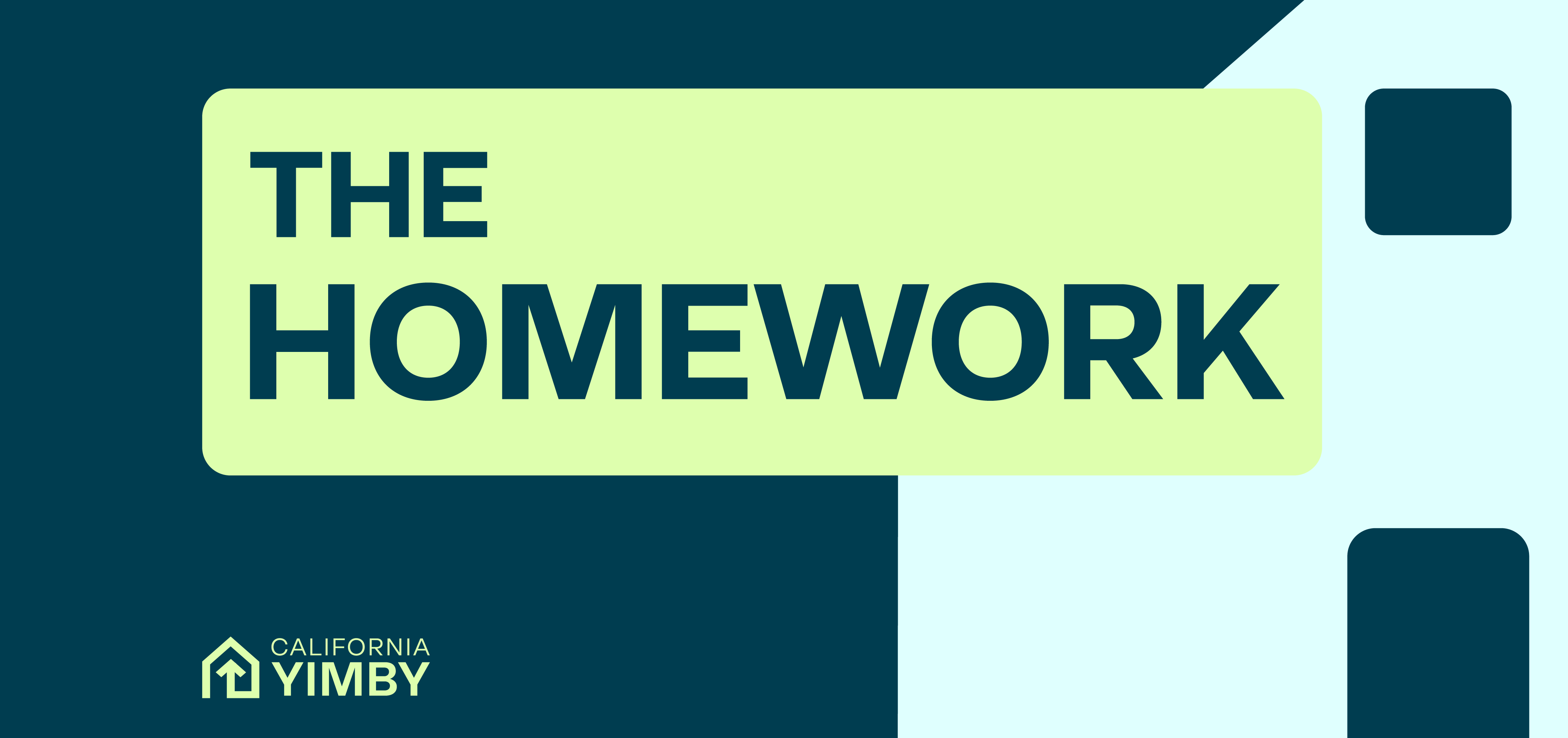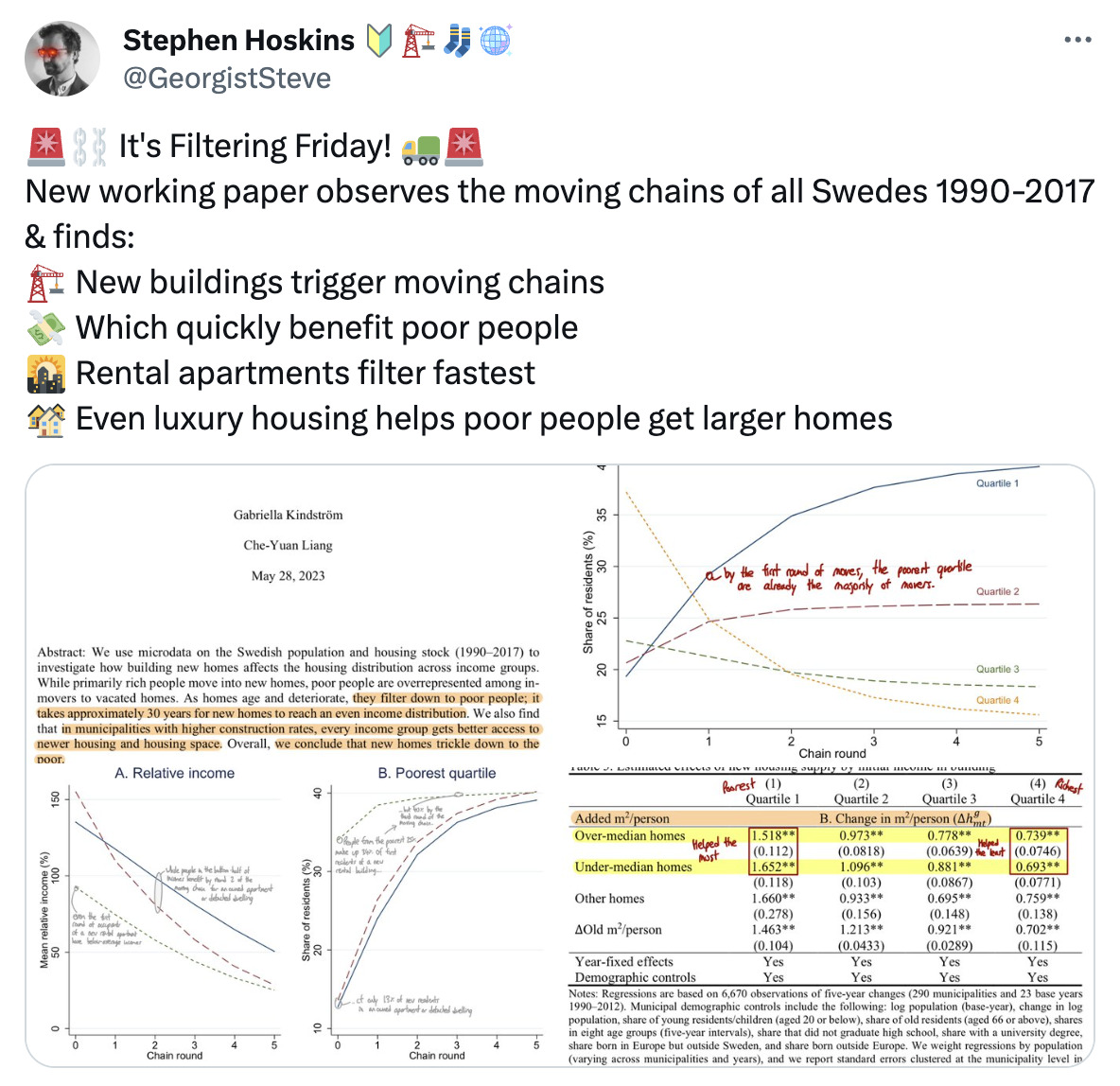The Homework: January 23, 2024

Welcome to the January 23, 2024 Main edition of The Homework, the official newsletter of California YIMBY — legislative updates, news clips, housing research and analysis, and the latest writings from the California YIMBY team.
News from Sacramento
The State Legislature is back in session, and the first round of housing bills are beginning to make the rounds. The deadline for bill submission is not until February 16, and California YIMBY is still working on submitting policy ideas to advance our legislative priorities.
In the meantime, we are proud to announce that we have signed on as a co-sponsor for SB 312 (Wiener):
- This bill will resolve a technical issue that has prevented the use of SB 886 (Wiener, 2022), ensuring student and faculty housing on university land can be built faster and at lower cost.
- The bill recently passed the Senate Appropriations Committee and is heading to the Senate Floor.
During the holiday season, the State Assembly announced their committee assignments for the rest of the year. Below is a list of Committee assignments for committees that are most likely to hear our sponsored and high-priority bills:
Assembly Housing Committee:
- Assemblymember Chris Ward (Chair)
- Assemblymember Joe Patterson (Vice Chair)
- Assemblymember Ash Kalra
- Assemblymember Sharon Quirk-Silva
- Assemblymember Eloise Gómez Reyes
- Assemblymember Kate A. Sanchez
- Assemblymember Lori Wilson
- Assemblymember Alex Lee
Assembly Local Government Committee:
- Assemblymember Juan Carrillo (Chair)
- Assemblymember Marie Waldron (Vice Chair)
- Assemblymember Bill Essayli
- Assemblymember Matt Haney
- Assemblymember Ash Kalra
- Assemblymember Blanca Pacheco
- Assemblymember James Ramos
- Assemblymember Chris Ward
- Assemblymember Lori Wilson
Assembly Natural Resources Committee:
- Assemblymember Isaac Bryan (Chair)
- Assemblymember Heath Flora (Vice Chair)
- Assemblymember Rebecca Bauer-Kahan
- Assemblymember Laura Friedman
- Assemblymember Josh Hoover
- Assemblymember Ash Kalra
- Assemblymember Devon Mathis
- Assemblymember Al Muratsuchi
- Assemblymember Gail Pellerin
- Assemblymember Buffy Wicks
- Assemblymember Jim Wood
The Senate has yet to announce its committee assignments; stay tuned to future editions of The Homework, and follow the California YIMBY Twitter channel, @cayimby, to stay up to date on developments on legislative policy committees and related news.
California YIMBY is in the final stages of developing our legislative package for the 2024 legislative year. More to come on our priority bills in the coming weeks.
Housing Research & Analysis
Sharpening the Pencil: How Smart Policy Can Reduce the High Cost of Homebuilding
How much does it cost to build new housing? And are these costs aligned with what the market will bear for rents, or broad goals of housing affordability?
In the world of housing contractors and developers, the term for a new housing development that can charge rents that are reasonable to the typical renter is known as “penciling:” If a project “doesn’t pencil,” that means the costs of construction are higher than can be recouped in rent – and nothing gets built at all.
Because of this dependent relationship between market rents and construction costs, understanding housing finance is critical to making good housing policy.This updated Terner Center report, Making It Pencil (2023), illuminates how developers decide whether or not to build new apartment buildings by explaining the basics of housing development and finance, paying particular attention to the ways public policy can affect a housing project’s financial feasibility.
Key Takeaways:
- Understanding housing development finance is key to making good housing policy.
- Changes in the California housing development market—rising construction costs, stagnant rents, high interest rates, and stricter financial requirements—have made new midrise residential development financially infeasible.
- Public policymakers control many of the factors that influence developer decision-making around the financial feasibility of new housing construction, and better policy could make more new homes financially feasible.
Movin’ On Up: How Costly New Homes Create Affordable Old Homes
In housing policy, a common theory of how to provide the maximum number of affordable homes to the greatest number of people is known as “filtering:” the process through which aging homes depreciate, and become less costly as higher-income residents purchase new homes, and move into them from the older, depreciated homes.
Under filtering theory, people concerned with housing affordability should support the construction of new homes to ensure a robust supply of high quality but lower priced “used” homes in the future.
Unfortunately, particularly in markets where it is onerous, costly, and/or time-consuming to build a lot of new homes, filtering can take a long time. While a used car might lose half its value in three years, a used home in a market with slow housing growth can take years to become affordable to middle class households.In this paper, “Does new housing for the rich benefit the poor? On trickle-down effects of new homes,” Gabriella Kindström and Che-Yuan Liang “use microdata on the Swedish population and housing stock (1990-2017) to investigate how building new homes affects the housing distribution across income groups.”
Key takeaways
- Microdata proves that filtering is real: while new homes are mostly for the rich, “poor people are overrepresented among in-movers to vacated homes.”
- New homes take about 30 years to filter down to an even income distribution.
- New housing benefits everyone by giving every income group better access to newer, more spacious housing.
Houser Headlines
- US Needs More Housing to Support Public Transit Recovery – Bloomberg
- Supreme Court case about impact fees could have huge consequences for housing in California
- Opinion: This Supreme Court case from California could ease housing shortages everywhere
- How will California respond to the home insurance market meltdown?
- State Farm Raising California Homeowner Policies 20%
- A People’s Park requiem: From free speech and flower children to planned dormitory towers – Los Angeles Times
- New California housing laws aimed to streamline building process take effect in 2024
- 12 new California laws looking to boost affordable home construction
- It’s not just the Bay Area — the number of affordable homes is plummeting across California
- There Was A Time When We Built More Affordable Housing. So What Happened? | LAist
YIMBY Social – Top Posts

Share the good word
We welcome your ideas and feedback — send story tips and ideas to Homework@cayimby.org.